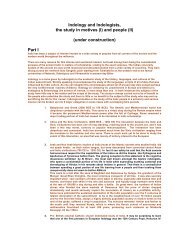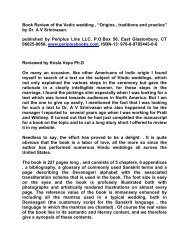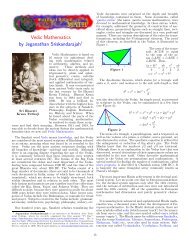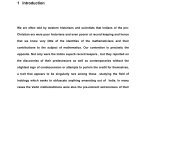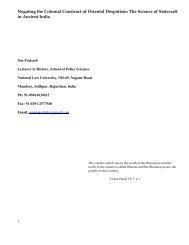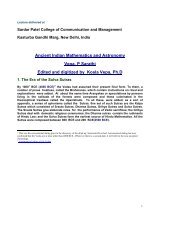The Dhaarmik Traditions - Indic Studies Foundation
The Dhaarmik Traditions - Indic Studies Foundation
The Dhaarmik Traditions - Indic Studies Foundation
Create successful ePaper yourself
Turn your PDF publications into a flip-book with our unique Google optimized e-Paper software.
your free-will can never be stronger than your free-will. Your failure only means that<br />
your present exercise of free-will is not sufficient to counteract the result of the past<br />
exercise of it. In other words, there is no question of a relative proportion between<br />
fate and free-will as distinct factors in life. <strong>The</strong> relative proportion is only as<br />
between the intensity of our past action and the intensity of our present action.<br />
D. : But even so, the relative intensity can be realized only at the end of our present<br />
effort in a particular direction.<br />
H.H. : It is always so in the case of everything which is adrishta or unseen. Take, for<br />
example, a nail driven into a wooden pillar. When you see it for the first time, you<br />
actually see, say, an inch of it projecting out of the pillar. <strong>The</strong> rest of it has gone<br />
into the wood and you cannot now see what exact length of the nail is imbedded in<br />
the wood. That length, therefore, is unseen or adrishta, so far as you are concerned.<br />
Beautifully varnished as the pillar is, you do not know what is the composition of<br />
the wood in which the nail is driven. That also is unseen or adrishta. Now,<br />
suppose you want to pull that nail out, can you tell me how many pulls will be<br />
necessary and how powerful each pull has to be<br />
D. : How can I <strong>The</strong> number and the intensity of the pulls will depend upon the<br />
length which has gone into the wood.<br />
H.H. : Certainly so. And the length which has gone into the wood is not arbitrary, but<br />
depended upon the number of strokes which drove it in and the intensity of each of<br />
such strokes and the resistance which the wood offered to them.<br />
D. : It is so.<br />
H.H. : <strong>The</strong> number and intensity of the pulls needed to take out the nail depend<br />
therefore upon the number and intensity of the strokes which drove it in.<br />
D. : Yes.<br />
H.H. : But the strokes that drove in the nail are now unseen and unseeable. <strong>The</strong>y<br />
relate to the past and are adrishta.<br />
135



